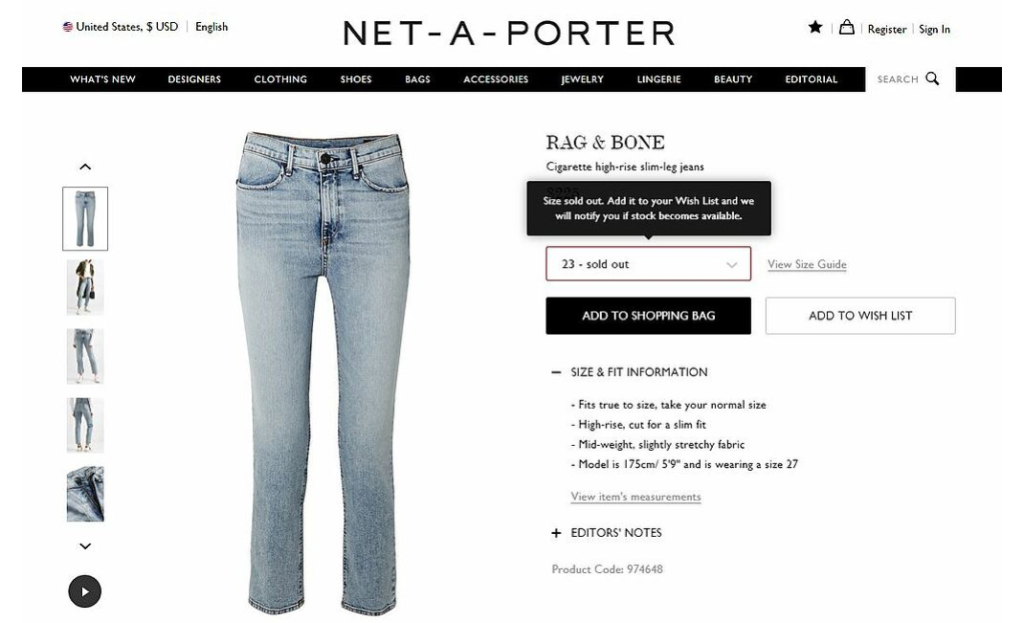Selling out of a product is an indication that it’s selling well. As exciting as this may be, there’s something you need to know: sold out products can hurt your SEO. Search engines may see sold-out and out-of-stock product pages as pages that are no longer important (although you may want to stock up on these items soon again) and, in some cases, might treat them as a soft 404. On the other hand, a removed page with authority can no longer pass that authority to other pages on the domain.
There is no on-size-fits-all strategy for sold out product pages. You have a few different options to choose from based on the situation. Furthermore, you may choose a different strategy for different pages of your website.
How can Out-Of-Stock Items Hurt SEO?
1. Removing a Page That’s Generating Organic Traffic and Sales
If you remove a page entirely, you’ll lose both organic traffic and sales generated by the product page itself.
Even if you don’t have the product in stock, you shouldn’t remove the page from your website. Instead, make note that the product is sold out, but also provide information on when you’ll have more in stock and alternatives for the time being.
Here’s an example:

(Courtesy of Linnworks)
Even though a particular size is sold out, the store allows shoppers to easily add the item to their wish list. They take this one step further by notifying the buyer when stock becomes available.
2. Removing a Page with Backlinks from Other Sites
A big part of your online success is based on the number of quality backlinks to your website.
When you remove a page from your site, you lose the authority it gains from the backlinks to this product page.
Not only does this harm the page itself, but it does the same to your rankings as a whole.
3. Redirecting Product Pages to your Homepage
It sounds like a good idea, as it helps keep potential buyers on your site. However, it actually creates a frustrating experience for visitors as they’re unable to find the page they’re looking for (and typically don’t know the product is sold out).
Subsequently, you chase these people away from your site, while also losing most of the benefit of external links to the product page. Instead, opt to redirect an out of stock product page to another similar product page or its relevant category collection page.
4. Too Many Out-of-Stock Products on Your Website
It’s okay to have out-of-stock products on your website, but not if you don’t share information about when they’ll be available again.
Remember this: search engines try to avoid sending visitors to pages for products they can’t purchase.
Check out this example:

(Courtesy of CXL)
Everything here is fine, except for telling visitors to “check back later.”
Does this mean later today? Later tomorrow? Later this month?
Be as specific as possible, such as by saying “check back tomorrow for an update on this product.” Another option is to add a field asking users to enter their email for updates on the future availability of that particular product.
How do you handle out of stock items in SEO?
Now that you understand the pitfalls to avoid, you have three options for a product page when you’re out of stock:
- Leave the page up with an out-of-stock message
- Redirect the page
- Remove the page from your site
For Small Sites: Leave or Redirect
If you have a small site – such as one with less than 100 products in your catalog – leave out-of-stock product pages up with useful information about when you expect them to be back in stock.
If a product is gone and will never return, it’s best to redirect the page to a similar product.
Small e-commerce sites aren’t at risk of publishing too many out-of-stock products. Just do your best to make sure the majority of your products are in stock and ready for purchase.
For Large Sites: Do an Analysis First
Large sites require a bit more attention, starting with an in-depth review to determine if the product page has any backlinks from external websites. Through the use of Google Search Console, Ahrefs, or Moz, you can quickly answer this question.
If the product page has backlinks, redirect it to its category page or a similar product. This will prevent you from losing authority from the backlinks.
From there, check if the page is driving converting organic traffic. If it’s generating traffic and/or sales, leave it be. Use Google Analytics to determine how much traffic the page is getting and how many sales it’s generating. You can then add a message to the page that points visitors to a related product.
Note: it’s your call as to whether you choose to redirect the product page to a category page or similar product. Redirecting is better for SEO and conversion, but product-to-product redirects are difficult to maintain if similar products go out of stock.
Finally, consider whether you can add a message to the product page about when it will be back in stock. Search engines prefer to see some useful information on the page if you’re going to leave it up.
Note: if the product page has no backlinks, doesn’t generate sales and won’t be back in stock anytime soon, remove the page without a redirect. The page will return a 404, which looks something like this:

(Courtesy of OptinMonster)
Steve Madden’s 404 page is a thing of beauty. Here’s why:
- It includes a search box for finding another product
- It includes contact details for assistance
- It includes links to related products
Should you Ever Remove Out-Of-Stock Product Pages?
Regardless of the size of your site, if you can add a message about when the product will be back in stock there is no reason to remove or redirect the page.
There’s only one case where we recommend removing the page from your site without a redirect, and that’s when all these conditions are met:
- Your ecommerce site is large (more than a few hundred products)
- The page doesn’t have backlinks from external websites
- The page doesn’t generate organic traffic or sales
- The product won’t be back in stock any time soon
 Are you struggling to decide on a strategy to handle out of stock products and improve conversions?
Are you struggling to decide on a strategy to handle out of stock products and improve conversions?
Learn how we can help your site with a free consultation and SEO Opportunity Analysis.
 Get started with our free resource guide to Authority First SEO™
Get started with our free resource guide to Authority First SEO™

